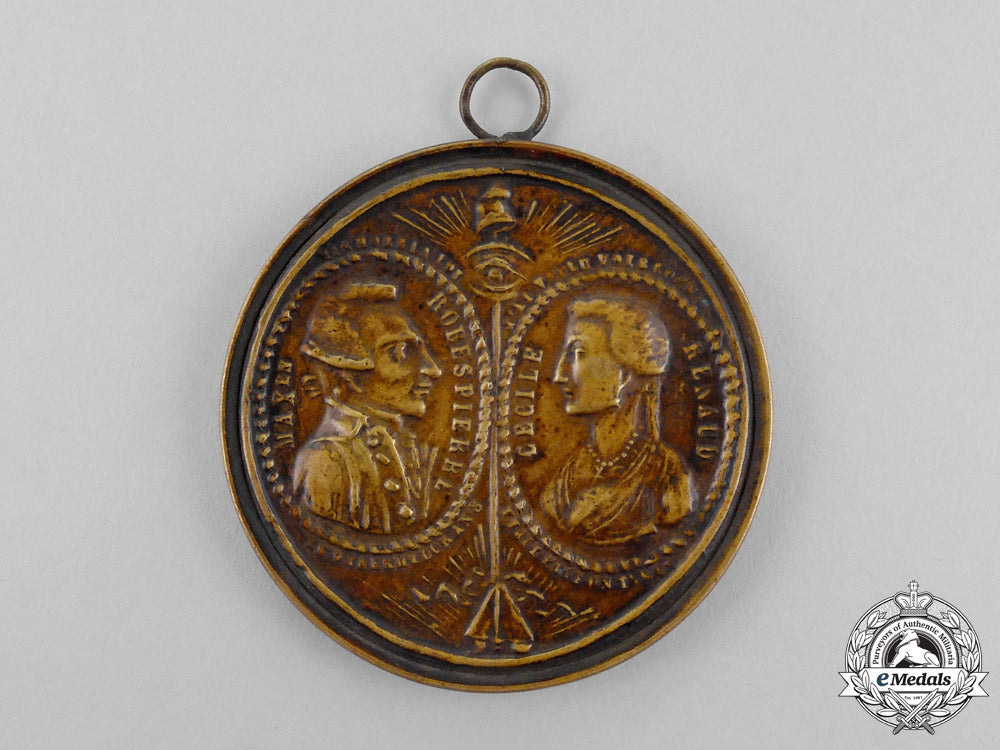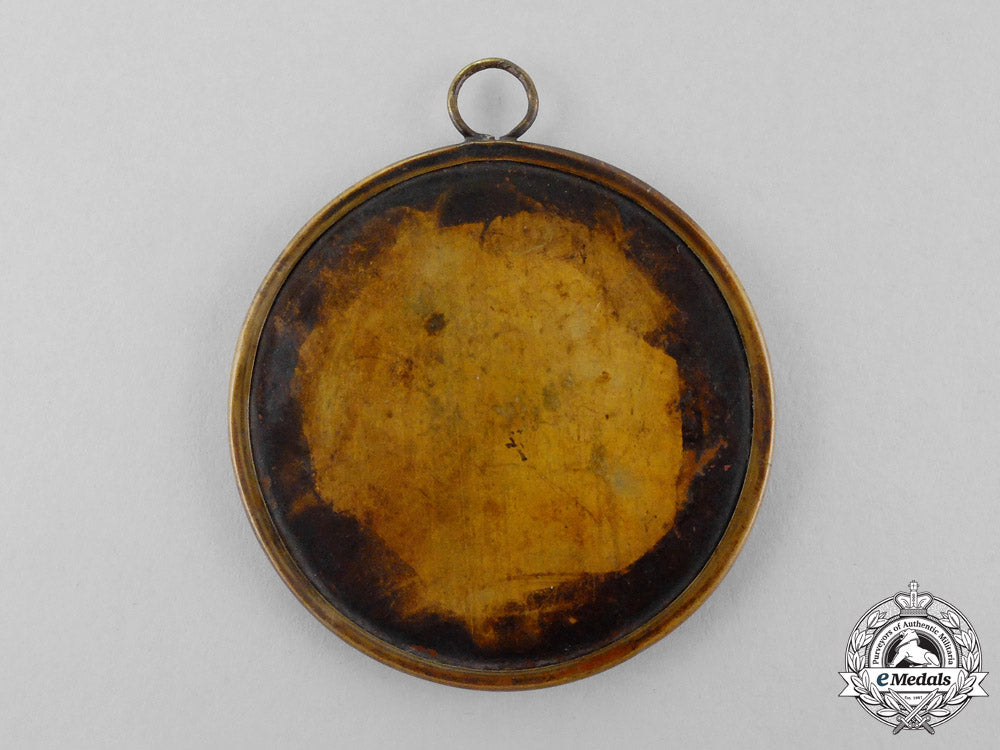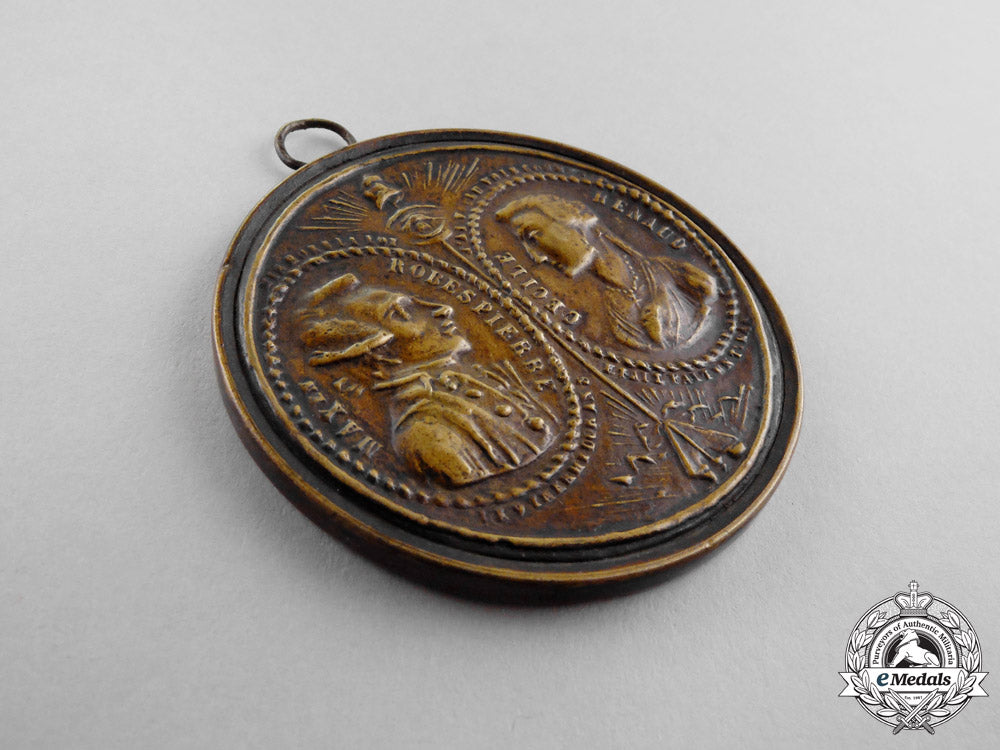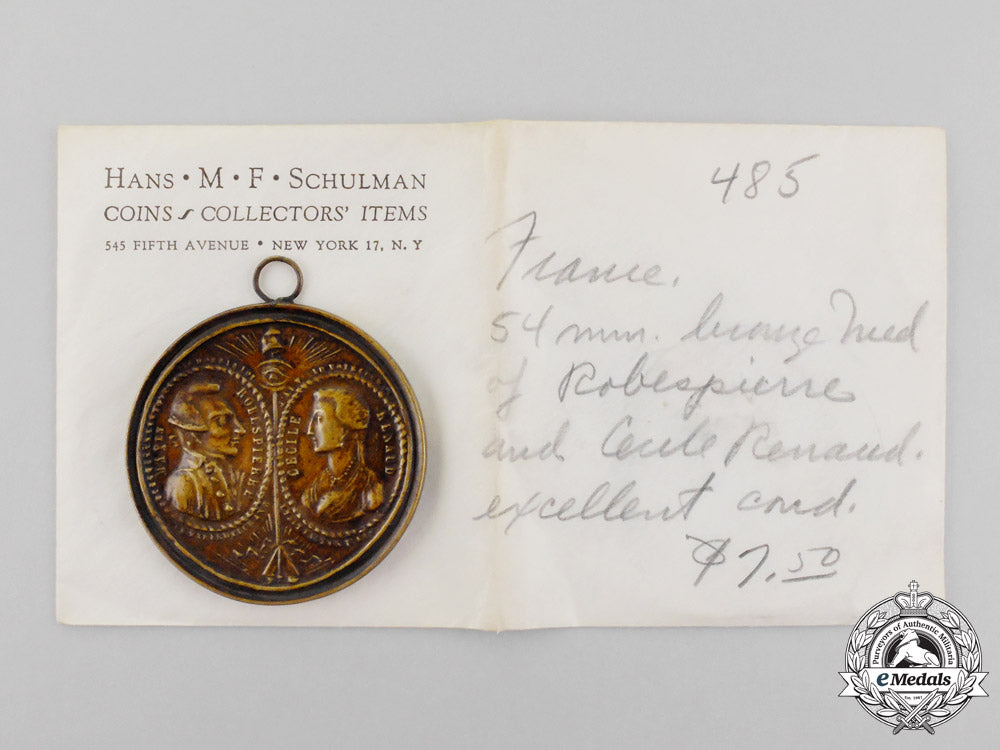
LOADING ...
In response to evolving domestic opinion, eMedals Inc has made the conscious decision to remove the presentation of German Third Reich historical artifacts from our online catalogue. For three decades, eMedals Inc has made an effort to preserve history in all its forms. As historians and researchers, we have managed sensitive articles and materials with the greatest of care and respect for their past and present social context. We acknowledge the growing sentiments put forth by the Canadian public and have taken proactive actions to address this opinion.




France. A C.1795 Rare Medal For The Attempted Assassination Of Robespierre
France. A C.1795 Rare Medal For The Attempted Assassination Of Robespierre
SKU: ITEM: EG1541
Current Bid:
Your Max Bid:
Bid History:
Time Remaining:
Couldn't load pickup availability
Shipping Details
Shipping Details
eMedals offers rapid domestic and international shipping. Orders received prior to 12:00pm (EST) will be shipped on the same business day.* Orders placed on Canadian Federal holidays will be dispatched the subsequent business day. Courier tracking numbers are provided for all shipments. All items purchased from eMedals can be returned for a full monetary refund or merchandise credit, providing the criteria presented in our Terms & Conditions are met. *Please note that the addition of a COA may impact dispatch time.
Shipping Details
eMedals offers rapid domestic and international shipping. Orders received prior to 12:00pm (EST) will be shipped on the same business day.* Orders placed on Canadian Federal holidays will be dispatched the subsequent business day. Courier tracking numbers are provided for all shipments. All items purchased from eMedals can be returned for a full monetary refund or merchandise credit, providing the criteria presented in our Terms & Conditions are met. *Please note that the addition of a COA may impact dispatch time.
Description
Description
France; Produced c.1795 in bronze, obverse with a die-stamped plate illustrating an oval frame containing the right-facing bust of Committee of Public Safety leader Maximilien François Marie Isidore de Robespierre surrounded by the inscription ""MAXen ROBESPIERRE"" on the left side, Robespierre's portrait inscribed ""MIS HORS LA LOI"" above and ""LE 9 THERMIDOR AN 3"" (July 27, 1795) below, an oval frame containing the left-facing bust of his alleged assassin, Cécile-Aimée Renault (Renaud) wearing a rosary surrounded by the inscription ""CECILE RENAUD"" on the right side, Renault's portrait inscribed ""J’AI VOULU VOIR COMMENT"" above and ""ETAIT FAIT UN TYRANT"" below, the two oval frames separated by a wand standard placed on a level and surmounted by the radiating Eye of Providence and a Phrygian cap, a blank plate on the reverse, padded between the plates, the pieces secured in place via a bronze ring along the outer edge with raised rims on both sides, a ring for suspension at the top, 55 mm, extremely fine.
Footnote: Maximilien François Marie Isidore de Robespierre (May 6, 1758 - July 28, 1794) was a French lawyer and politician, one of the best known and most influential figures associated with the French Revolution and the Reign of Terror, in addition to being Deputy to the Constituent Assembly (1789-1791) and Deputy to the National Convention (1792-1794). As a member of the Estates-General, the Constituent Assembly and the Jacobin Club, Robespierre was an outspoken advocate for the poor and for democratic institutions. He campaigned for universal male suffrage in France, price controls on basic food commodities and the abolition of slavery in the French colonies. He was an ardent opponent of the death penalty, but played an important role in arranging the execution of King Louis XVI, which led to the establishment of a French Republic. He is perhaps best known for his role in the French Revolution's Reign of Terror. He was named as a member of the powerful Committee of Public Safety launched by his political ally Georges Danton and exerted his influence to suppress the left-wing Hébertists. As part of his attempts to use extreme measures to control political activity in France, Robespierre later moved against the more moderate Danton, who was accused of corruption and executed in April 1794. The Terror ended a few months later with Robespierre's arrest and execution in July, events that initiated a period in French history known as the Thermidorian Reaction. Robespierre's personal responsibility for the excesses of the Terror remains the subject of intense debate among historians of the French Revolution. Cécile-Aimée Renault (AKA Renaud, 1774-1794) was a French woman and royalist accused of trying to assassinate Maximilien Robespierre during the Reign of Terror with two small knives. She was sentenced to death and guillotined on June 2, 1794 in what is now Place de la Nation. Renault approached the home of Robespierre on the evening of May 22, 1794, carrying a parcel, a basket and extra clothing under her arm that hid her weapons. She was able to successfully enter Robespierre's home due to her young countenance and age, being only about 19 or 20 years old at the time. Robespierre's guards initially allowed Renault to see him and but required her to wait for several hours inside the deputy's antechamber. Upon waiting for several hours and becoming impatient, Renault demanded her hosts have Robespierre meet with her immediately, arguing that ""a public man ought to receive at all times those who have occasion to approach him.""When arrested she said she had been merely curious to see ""what a tyrant looks like."" She also claimed to her captors that she would ""rather have one king than fifty thousand."" Other sources vary in, some quoting that Renault ""preferred to have one king that sixty."" Robespierre's guards searched Renault's clothing and basket and found the knives purposed to kill Robespierre, miscellaneous papers, and her fresh change of clothing. After placing her under arrest, Robespierre and his guards correlated this assassination attempt to recent attempts during Reign of Terror.
This included most notably the assassination of Jean-Paul Marat by Charlotte Corday in 1793. Renault's interrogators also suggested that her assassination plot was a retaliation effort. Her lover had recently been sentenced to death via guillotine by the Committee of Public Safety. Renault was further interrogated and claimed that the extra clothing was for her stay in prison, expectant to be apprehended. Renault also insisted that ""she never designed harm against any living being."" She further claimed that she expected to be guillotined and wished to have a decent dress for the occasion. She was given rags to wear during her imprisonment. Renault, her family members, and other associates who knew her but were all unknowing of the assassination plot were given red shirts to wear as a mark of assassins and murderers. Robespierre included Renault's father, brother and aunt in her trial, noted as accomplices to the assassination attempt. All three were sentenced to death. There exists debate among historians if Renault carried any weapons with her or if this attempt was solely ill-fated fervor. Her admittance to being a royalist supporter is considered to support the existence of her hidden knives. Renault's trial was overseen by Antoine Quentin Fouquier-Tinville, who was heckled by Renault regarding the charges and mocked the council conducting her trial. Renault was said to have shown distress only briefly during her climb to the scaffold. She then smiled, and approached the scaffold gleefully when her turn at the guillotine arrived. The Execution of Cecile Renault and her family members and friends was seen by the Committee of Public Safety as a Royalist conspiracy. Over the course of a nine-month period between September 1793 and July 1794 during the Reign of Terror, more than 40,000 French citizens met their deaths at the hands of the Revolutionary Tribunal.
This offering is a part of the "Dr. Albert Goodwin Collection", a preeminent assemblage of world Orders, Medals, and Decorations composed solely by Dr.Goodwin between 1946-1967. Dr. Goodwin had a successful career as an educator and prominent physician in New York as well as actively serving in both World Wars with the United States Medical Corps. He acted as both President and Vice-President of the Orders and Medals Society of America (OMSA) and is responsible for organizing their first convention in 1960. He maintained further membership with the American Society of Military Collectors, the International Orders Research Society, and the American Numismatic Society. His knowledge and passion for history and awards is evident in this meticulously compiled collection that is now available in its entirety for the first time exclusively on eMedals.com.
Description
France; Produced c.1795 in bronze, obverse with a die-stamped plate illustrating an oval frame containing the right-facing bust of Committee of Public Safety leader Maximilien François Marie Isidore de Robespierre surrounded by the inscription ""MAXen ROBESPIERRE"" on the left side, Robespierre's portrait inscribed ""MIS HORS LA LOI"" above and ""LE 9 THERMIDOR AN 3"" (July 27, 1795) below, an oval frame containing the left-facing bust of his alleged assassin, Cécile-Aimée Renault (Renaud) wearing a rosary surrounded by the inscription ""CECILE RENAUD"" on the right side, Renault's portrait inscribed ""J’AI VOULU VOIR COMMENT"" above and ""ETAIT FAIT UN TYRANT"" below, the two oval frames separated by a wand standard placed on a level and surmounted by the radiating Eye of Providence and a Phrygian cap, a blank plate on the reverse, padded between the plates, the pieces secured in place via a bronze ring along the outer edge with raised rims on both sides, a ring for suspension at the top, 55 mm, extremely fine.
Footnote: Maximilien François Marie Isidore de Robespierre (May 6, 1758 - July 28, 1794) was a French lawyer and politician, one of the best known and most influential figures associated with the French Revolution and the Reign of Terror, in addition to being Deputy to the Constituent Assembly (1789-1791) and Deputy to the National Convention (1792-1794). As a member of the Estates-General, the Constituent Assembly and the Jacobin Club, Robespierre was an outspoken advocate for the poor and for democratic institutions. He campaigned for universal male suffrage in France, price controls on basic food commodities and the abolition of slavery in the French colonies. He was an ardent opponent of the death penalty, but played an important role in arranging the execution of King Louis XVI, which led to the establishment of a French Republic. He is perhaps best known for his role in the French Revolution's Reign of Terror. He was named as a member of the powerful Committee of Public Safety launched by his political ally Georges Danton and exerted his influence to suppress the left-wing Hébertists. As part of his attempts to use extreme measures to control political activity in France, Robespierre later moved against the more moderate Danton, who was accused of corruption and executed in April 1794. The Terror ended a few months later with Robespierre's arrest and execution in July, events that initiated a period in French history known as the Thermidorian Reaction. Robespierre's personal responsibility for the excesses of the Terror remains the subject of intense debate among historians of the French Revolution. Cécile-Aimée Renault (AKA Renaud, 1774-1794) was a French woman and royalist accused of trying to assassinate Maximilien Robespierre during the Reign of Terror with two small knives. She was sentenced to death and guillotined on June 2, 1794 in what is now Place de la Nation. Renault approached the home of Robespierre on the evening of May 22, 1794, carrying a parcel, a basket and extra clothing under her arm that hid her weapons. She was able to successfully enter Robespierre's home due to her young countenance and age, being only about 19 or 20 years old at the time. Robespierre's guards initially allowed Renault to see him and but required her to wait for several hours inside the deputy's antechamber. Upon waiting for several hours and becoming impatient, Renault demanded her hosts have Robespierre meet with her immediately, arguing that ""a public man ought to receive at all times those who have occasion to approach him.""When arrested she said she had been merely curious to see ""what a tyrant looks like."" She also claimed to her captors that she would ""rather have one king than fifty thousand."" Other sources vary in, some quoting that Renault ""preferred to have one king that sixty."" Robespierre's guards searched Renault's clothing and basket and found the knives purposed to kill Robespierre, miscellaneous papers, and her fresh change of clothing. After placing her under arrest, Robespierre and his guards correlated this assassination attempt to recent attempts during Reign of Terror.
This included most notably the assassination of Jean-Paul Marat by Charlotte Corday in 1793. Renault's interrogators also suggested that her assassination plot was a retaliation effort. Her lover had recently been sentenced to death via guillotine by the Committee of Public Safety. Renault was further interrogated and claimed that the extra clothing was for her stay in prison, expectant to be apprehended. Renault also insisted that ""she never designed harm against any living being."" She further claimed that she expected to be guillotined and wished to have a decent dress for the occasion. She was given rags to wear during her imprisonment. Renault, her family members, and other associates who knew her but were all unknowing of the assassination plot were given red shirts to wear as a mark of assassins and murderers. Robespierre included Renault's father, brother and aunt in her trial, noted as accomplices to the assassination attempt. All three were sentenced to death. There exists debate among historians if Renault carried any weapons with her or if this attempt was solely ill-fated fervor. Her admittance to being a royalist supporter is considered to support the existence of her hidden knives. Renault's trial was overseen by Antoine Quentin Fouquier-Tinville, who was heckled by Renault regarding the charges and mocked the council conducting her trial. Renault was said to have shown distress only briefly during her climb to the scaffold. She then smiled, and approached the scaffold gleefully when her turn at the guillotine arrived. The Execution of Cecile Renault and her family members and friends was seen by the Committee of Public Safety as a Royalist conspiracy. Over the course of a nine-month period between September 1793 and July 1794 during the Reign of Terror, more than 40,000 French citizens met their deaths at the hands of the Revolutionary Tribunal.
This offering is a part of the "Dr. Albert Goodwin Collection", a preeminent assemblage of world Orders, Medals, and Decorations composed solely by Dr.Goodwin between 1946-1967. Dr. Goodwin had a successful career as an educator and prominent physician in New York as well as actively serving in both World Wars with the United States Medical Corps. He acted as both President and Vice-President of the Orders and Medals Society of America (OMSA) and is responsible for organizing their first convention in 1960. He maintained further membership with the American Society of Military Collectors, the International Orders Research Society, and the American Numismatic Society. His knowledge and passion for history and awards is evident in this meticulously compiled collection that is now available in its entirety for the first time exclusively on eMedals.com.




You May Also Like
Germany, HJ. A 1938 National Trade Competition Victor’s Badge, Gold Grade in Case, By Gustav Brehmer
G60096
Italy, Republic. An Order of Merit of the Italian Republic, Grand Cross Set by Johnson, 1970
EU23677
Spain, Franco Period. An Order of Civil Merit, Grand Cross Set
EU23731
Russia, Imperial. An Order of St. Anne, II Class in Gold
EU23720
Austria, Imperial. An Order of the Iron Crown, III Class in Gold, by Rothe, c.1900
EU23723
-
Germany, HJ. A 1938 National Trade Competition Victor’s Badge, Gold Grade in Case, By Gustav Brehmer
G60096
Add to CartRegular price $3,950 USDRegular price $0 USD Sale price $3,950 USDUnit price / per -
Italy, Republic. An Order of Merit of the Italian Republic, Grand Cross Set by Johnson, 1970
EU23677
Add to CartRegular price $950 USDRegular price $0 USD Sale price $950 USDUnit price / per -
Spain, Franco Period. An Order of Civil Merit, Grand Cross Set
EU23731
Add to CartRegular price $600 USDRegular price $0 USD Sale price $600 USDUnit price / per -
Russia, Imperial. An Order of St. Anne, II Class in Gold
EU23720
Add to CartRegular price $2,950 USDRegular price $0 USD Sale price $2,950 USDUnit price / per -
Austria, Imperial. An Order of the Iron Crown, III Class in Gold, by Rothe, c.1900
EU23723
Add to CartRegular price $3,950 USDRegular price $0 USD Sale price $3,950 USDUnit price / per
Do you have a similar item you are interested in selling?
Please complete the form and our client care representatives will contact you.
Sell Item












